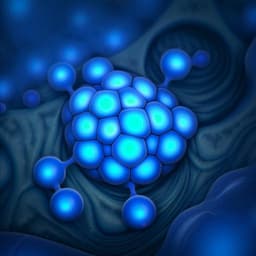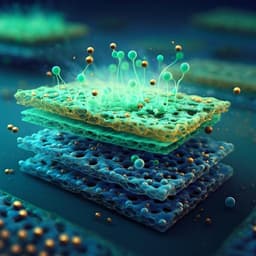
Chemistry
Halogen-doped Carbon Dots for Enhanced Dynamic Phosphorescence and Grayscale Display
Liu
This innovative research by Liu and colleagues showcases dynamic room-temperature phosphorescence polymer composites enhanced by halogen-doped carbon dots, leading to remarkable advancements in grayscale UV photography and steganography.
~3 min • Beginner • English
Introduction
The study addresses a key limitation in oxygen-regulated dynamic ultralong room-temperature phosphorescence (DURTP) systems based on metal-free organic phosphors: a high photoactivation threshold (dead time) caused by insufficient intersystem crossing (ISC). This high threshold hampers grayscale display, restricting applications to binary on/off patterns. The authors propose enhancing ISC in carbon dots (CDs) to both increase tolerance to triplet oxygen quenching and accelerate photodynamic oxygen consumption, thereby reducing the activation threshold and enabling grayscale DURTP. They hypothesize that halogen (heavy atom) doping of CDs will enhance spin–orbit coupling, facilitate ISC, and improve DURTP performance in polymer composites.
Literature Review
Oxygen-regulated DURTP systems are limited by insufficient ISC in metal-free phosphors, leading to strong oxygen quenching and slow oxygen consumption during activation. Prior strategies to improve ISC included introducing lone-pair-containing groups such as nitrogen heterocycles and phosphonates, which improved performance but did not achieve grayscale display. Heavy atom substitution/doping, particularly with halogens, is a common approach to enhance spin–orbit coupling and ISC. Halogen doping can alter polarity and hydrogen bonding, potentially affecting polymer compatibility; however, solvothermal CDs possess hydrophilic surface groups that may compensate. Fluorine-doped phosphorescent CDs have been demonstrated previously, supporting the feasibility of halogen doping for ISC enhancement.
Methodology
- Synthesis: Bottom-up solvothermal synthesis of CDs from molecular precursors. Attempted halogen incorporation using halogenated precursors. Brominated/iodinated precursors yielded low to negligible Br or I content due to higher leaving tendencies. Chlorinated p-benzoquinone derivatives were used to obtain Cl-doped CDs (CICDs-1 to CICDs-3) with increasing substitution (R1–R4 = Cl as per precursor design).
- Materials: Four CDs prepared: CDs-0 (halogen-free), CICDs-1, CICDs-2, CICDs-3 with increasing Cl content.
- Characterization: XPS survey to quantify elemental composition; FT-IR to identify C–Cl (~1100 cm−1); deconvolution of C1s and Cl2p binding energies (Cl bound to sp2/sp3 C); HRTEM to determine particle size (2.6–2.8 nm) and lattice fringes (~0.24 nm, [100] plane); XRD showing broad peaks at 2θ ≈ 23° ([002]) and bumps at 2θ ≈ 45° ([100]). UV–vis absorption and fluorescence in ethanol to assess excited-state energies.
- Composite fabrication: CDs embedded in poly(vinylpyrrolidone) (PVP) via solution blending and film casting to suppress nonradiative triplet relaxation through hydrogen-bond fixation and to provide an oxygen reservoir/regulator.
- DURTP activation/deactivation: Initial UV excitation (400 nm, 10 mW cm−2, 20 ms). Activation through prolonged irradiation to deplete oxygen; deactivation by ambient reoxygenation (~2.5 h at 25 °C) or by heating (120 °C, 10 min). Reversibility tested over 10 on/off cycles.
- Photophysics: Steady-state PL deconvolution to determine phosphorescent fraction; time-resolved phosphorescence lifetimes (activated state). Phosphorescence quantum yields estimated from fluorescence QY of deactivated films multiplied by Iphos/Ifluo ratio (λex = 400 nm).
- Photodynamic activity: Singlet oxygen generation quantified by ESR using TEMP as a trap (2 min UV irradiation, 20 µg/mL CDs).
- Activation kinetics: Photoactivation profiles and τ1/2 (time to half-max intensity) at 0.1 mW cm−2; activation threshold from curve X-axis intercept; relative threshold R_th defined as dead time/τ1/2.
- Grayscale display: UV dose control (0–20 mJ cm−2) using a transparent mask printed with an ITE grayscale chart to produce stepwise phosphorescent intensities on flexible composite films (focus on composite 3).
Key Findings
- Successful Cl-doping: XPS Cl atomic percentages increased with precursor substitution: CICDs-1 5.98%, CICDs-2 7.45%, CICDs-3 9.33% (CDs-0 ~0.27% noise). FT-IR shows enhanced ~1100 cm−1 C–Cl band; XPS Cl2p indicates Cl bound to both sp2 and sp3 carbon.
- Morphology/crystallinity: All CDs had similar sizes (2.6–2.8 nm); HRTEM showed ~0.24 nm fringes (graphitic [100]); XRD exhibited features at 2θ ≈ 23° ([002]) and ~45° ([100]).
- Optical absorption/fluorescence in solution remained similar across CDs, indicating Cl doping did not significantly alter excited-state energy levels.
- DURTP behavior in PVP: Films showed no afterglow initially due to oxygen quenching; after activation, exhibited orange phosphorescence with seconds-long afterglow. DURTP deactivated over ~2.5 h in air at 25 °C; fully deactivated in 10 min at 120 °C. Reversible over ≥10 cycles without significant intensity loss.
- Enhanced ISC with Cl doping: Phosphorescent fraction in activated steady-state PL increased from 17.1% (composite 0) to 29.3% (1), 31.6% (2), and 54.9% (3). Activated lifetime decreased from 472–476 ms (comp. 0) to 338 ms (1), 299 ms (2), and 110 ms (3), consistent with heavy atom effect.
- Phosphorescence quantum yields (λex = 400 nm): Composite 0 = 0.94%; 1 = 1.61%; 2 = 1.93%; 3 = 2.93% (comparable to some molecular long-afterglow phosphors in similar wavelengths).
- Photodynamic efficiency: Singlet oxygen generation of CICDs-3 was ~4.1× that of CDs-0 (ESR TEMP assay), indicating higher triplet population and photosensitization.
- Activation kinetics and thresholds: τ1/2 at 0.1 mW cm−2: composite 0 = 325 s; 1 = 175 s; 2 = 110 s; 3 = 71 s. Dead time decreased from 123 s (comp. 0) to 6.7 s (comp. 3). Relative threshold R_th decreased from 0.38 to 0.09 with increasing Cl content.
- Grayscale capability: Composite 3 showed an 84-fold intensity increase and ~10× lifetime increase during activation (11 → 110 ms). Controlled UV dosing (0–20 mJ cm−2) produced clear stepwise phosphorescent intensity grids; composite 0 captured only part of the gradient due to higher threshold.
- Applications: Enabled grayscale-based UV photography and steganography demonstrations for the first time with DURTP materials (noted by the authors).
Discussion
Halogen (Cl) doping of carbon dots enhances spin–orbit coupling, increasing ISC and triplet population. In oxygen-regulated DURTP composites, this yields two synergistic effects: (1) stronger T1→S0 radiative transitions, improving emission tolerance to residual oxygen and reducing the activation dead time; and (2) higher photodynamic conversion to singlet oxygen, accelerating local oxygen depletion and speeding activation. The data show monotonic increases in phosphorescent contribution and quantum yield, along with reduced lifetimes characteristic of the heavy atom effect. These changes translate into markedly faster activation kinetics (shorter τ1/2), lower activation thresholds (lower dead time and R_th), and thus enable continuous grayscale control of phosphorescent intensity via UV dose. Compared with undoped CDs, Cl-doped composites, especially composite 3, achieve fully programmable emission profiles suitable for grayscale imaging modalities, broadening the utility of DURTP materials in optical applications such as UV photography and information security (steganography).
Conclusion
The study demonstrates that chlorinated (halogen-doped) carbon dots embedded in PVP form flexible DURTP composites with enhanced ISC, higher phosphorescence quantum yields, reduced activation thresholds, and faster activation kinetics. These improvements enable, for the first time, reliable grayscale DURTP displays controlled by UV dose, with large dynamic changes in both intensity and lifetime. The materials show reversible switching, practical activation/deactivation control, and promising performance for UV photography and steganographic applications. Future work could explore optimizing halogen species and doping levels, balancing heavy-atom-induced ISC with polymer compatibility, engineering polymer matrices for tailored oxygen permeability and erasure speeds, and integrating these composites into device architectures for high-resolution, rewritable grayscale displays.
Limitations
- Limited incorporation of heavier halogens (Br, I) due to larger size and weaker C–X bonding resulted in low-to-zero dopant content, restricting exploration to Cl doping.
- While thresholds were reduced substantially, a nonzero dead time remains; grayscale fidelity depends on precise UV dosing and activation state.
- Polymer oxygen regulation imposes deactivation times (~hours) under ambient conditions; rapid erasure requires heating (120 °C for 10 min).
- Potential changes in polarity/hydrogen bonding from halogen doping could affect polymer compatibility, although hydrophilic CD surfaces likely mitigated this; broader matrix compatibility was not evaluated in the excerpt.
Related Publications
Explore these studies to deepen your understanding of the subject.







